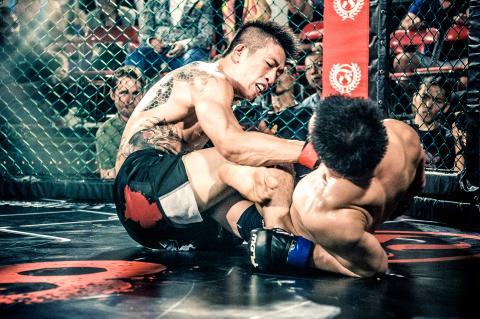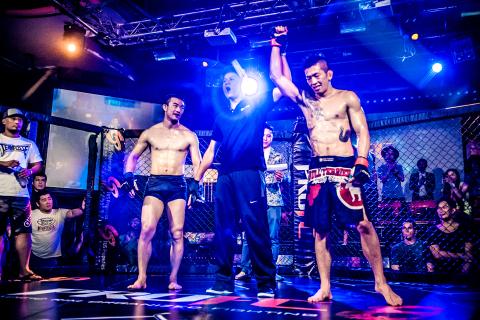The training mats of innumerable gyms are filled with years of blood, sweat and tears from tenacious men and women who dare to dream of one day stepping into the octagon of the Ultimate Fighting Championship (UFC), the world’s unrivaled mixed martial arts (MMA) fighting organization. Taiwan’s Rocky Lee (李俊翰) will get to see that fantasy come true on Saturday night (Sunday morning Taiwan time) in Krakow, Poland, when he fights Taylor Lapilus on the undercard of UFC Fight Night: Gonzaga vs Cro Cop 2.
FROM THUG TO FIGHTER
From a young age, most mixed martial artists get their kicks by knuckling up with other knuckleheads on the street. Lee’s journey was no different. “I used to get bullied and beat up when I was younger, and I started fighting to stand up for myself,” Lee said in an email interview with the Taipei Times. “Then I found out that I liked fighting and thought it was fun. I ended up in a bad crowd and would go looking for fights. I fought all the time and got in a lot of trouble.”

Photo courtesy of ProFC and Danny Chu
However, being a thug on the streets eventually lost its luster, and, six years ago, Lee started training Sanda and Brazilian jiu jitsu and quickly transitioned to MMA. “I wanted to try and give my life some focus, so using martial arts was actually how I got myself out of that life and out of trouble,” Lee said.
MMA ARRIVES IN TAIWAN
MMA is new to Taiwan and still has a long way to go before it becomes as popular as it is in places like Japan, the US and Brazil. For Lee, this meant having to train at a few different gyms in order to get the guidance he desired.

Photo courtesy of ProFC and Danny Chu
“The boxing gym I go to is a great place for me to learn and train with coaches who push me, and training partners who are always teaching me new things.”
Lee’s first professional bout was in ProFC, Taiwan’s premier MMA company. Lee was very nervous before the fight but stuck to his game plan and ended up winning. He believes that ProFC will help develop Taiwan’s MMA scene, mainly by providing opportunities for fighters to get a professional start.
UFC COMES CALLING
With his reputation growing within the Asian MMA circuit, last year, Lee was selected to be a contestant on The Ultimate Fighter: China, the UFC’s reality show where fighters live together in the same house and train with professional coaches to fight each other. For weeks, Lee was sequestered in this very serious atmosphere.
There were were no phones, Internet, books, TV, music or anything that might distract them from training.
“Everyone had to be friends and live together, but you were all also competing for the same thing,” he said. “The environment was stressful because you didn’t know when you were going to fight or who you were going to fight, [but] we learned something new all the time because we had great fighters like Cung Le and Benson Henderson to come in and work with us.”
“I learned so many new techniques and perspectives that this was absolutely beneficial to my career,” Lee added. “It really gave me my shot in the UFC. Because of the show, I was able to show the UFC that I deserve this fight.”
VICTORY WITHIN REACH
Even though Lee is the first Taiwanese mixed martial artist to fight for the UFC, he does not feel like he is carrying the weight of the nation on his shoulders.
“I know that I can’t think that way,” he said. “I have to work hard and focus on this fight and this fight only. I just have to focus and compete in this bout the same as I would if I were the first Taiwanese fighter in the UFC, or the 100th,” Lee said.
Lee believes he has the upper hand against Lapilus in many ways. “I have been studying his past fights and also his record on Sherdog (MMA Web site). Most of his wins are from submissions, so we have similar strengths, which means this will be a good match up and we will put on a good show,” Lee said.
“I also think that I have the advantages of better boxing, better jiu jitsu and better wrestling. I am excited to put these to work in the octagon against him.”

May 26 to June 1 When the Qing Dynasty first took control over many parts of Taiwan in 1684, it roughly continued the Kingdom of Tungning’s administrative borders (see below), setting up one prefecture and three counties. The actual area of control covered today’s Chiayi, Tainan and Kaohsiung. The administrative center was in Taiwan Prefecture, in today’s Tainan. But as Han settlement expanded and due to rebellions and other international incidents, the administrative units became more complex. By the time Taiwan became a province of the Qing in 1887, there were three prefectures, eleven counties, three subprefectures and one directly-administered prefecture, with

President William Lai (賴清德) yesterday delivered an address marking the first anniversary of his presidency. In the speech, Lai affirmed Taiwan’s global role in technology, trade and security. He announced economic and national security initiatives, and emphasized democratic values and cross-party cooperation. The following is the full text of his speech: Yesterday, outside of Beida Elementary School in New Taipei City’s Sanxia District (三峽), there was a major traffic accident that, sadly, claimed several lives and resulted in multiple injuries. The Executive Yuan immediately formed a task force, and last night I personally visited the victims in hospital. Central government agencies and the

Among Thailand’s Chinese Nationalist Party (KMT) villages, a certain rivalry exists between Arunothai, the largest of these villages, and Mae Salong, which is currently the most prosperous. Historically, the rivalry stems from a split in KMT military factions in the early 1960s, which divided command and opium territories after Chiang Kai-shek (蔣介石) cut off open support in 1961 due to international pressure (see part two, “The KMT opium lords of the Golden Triangle,” on May 20). But today this rivalry manifests as a different kind of split, with Arunothai leading a pro-China faction and Mae Salong staunchly aligned to Taiwan.

As with most of northern Thailand’s Chinese Nationalist Party (KMT) settlements, the village of Arunothai was only given a Thai name once the Thai government began in the 1970s to assert control over the border region and initiate a decades-long process of political integration. The village’s original name, bestowed by its Yunnanese founders when they first settled the valley in the late 1960s, was a Chinese name, Dagudi (大谷地), which literally translates as “a place for threshing rice.” At that time, these village founders did not know how permanent their settlement would be. Most of Arunothai’s first generation were soldiers